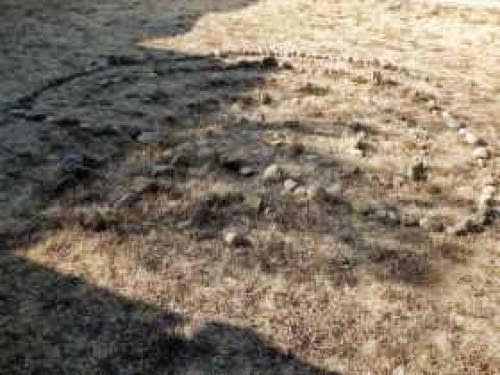
Most of us are familiar with the ancient Greek myth of the Minoan labyrinth, where Theseus cheats his way out of the maze with a piece of string after slaying the infamous Minotaur.
But the labyrinth of this ancient myth is actually a maze-a confusion of walls and halls that more often than not leads to dead ends and the defeat of the person trying to navigate it.
A true labyrinth has only one path, although it looks like many, and if one simply puts one foot in front of the other, step-by-step ("pas a pas" in Latin), one will arrive at the center and be able to return along the same path to emerge again into the world.
The labyrinth is an ancient symbol and is found all over the world and in all cultures.
It symbolism represents the spiritual journey-not only the journey of our lives, but the journey within ourselves to find the center. The center, of course, is Source/Spirit/Divine Mind, and it lies within us all.
Walking a labyrinth automatically triggers a kind of meditative response in the brain, stimulating alpha waves, making us more receptive to our spiritual nature, more intuitive, more in tune with our own inner magic.
The labyrinth is one of the few tools for spirituality that both pagans and Christians share. One of the most famous labyrinths in the world is the one in Chartres cathedral in France. Any tool that gives us common ground is one to celebrate and employ. No matter what your particular religious interpretation or experience of the Divine, the point is to experience the Divine!
I often take a small notebook in my pocket whenever a walk a labyrinth, because when walking, I often receive inspiration or guidance. Since my inspiration or guidance often comes in beautifully constructed phrases or sentences, I want to write them down immediately.
People with physical or medical conditions often find that walking a labyrinth improves their health or lessons their pain. I recommend walking an outdoor labyrinth in your bare feet if possible to connect with the earth's magnetic field.
For those with limited mobility, the labyrinth is a good way to get exercise. Many labyrinths are as long a a half mile from exterior to center, but if one tires or simply cannot walk further, you are rarely more than a few steps from exiting the labyrinth. You can simply step over the lines. Many labyrinths are painted or otherwise flat and can be navigated via wheelchair as well. The effect is the same.
Walking a labyrinth is considered to be a right-brain activity. Because there is no need to contemplate choices, as one must in a maze, thereby employing the left brain, in a labyrinth you merely walk. It is a kind of acceptance and quiets the noisy mind. It is a moving meditation. Many people pray or chant a mantra while walking.
Today, there are labyrinths in nearly every town in America, in churches, meditation centers or public spaces. In fact, there are labyrinths all over the world.
To find a labyrinth near you, check this listing:
WORLDWIDE LABYRINTH LOCATOR:
http://labyrinthlocator.com/locate-a-labyrinth
To learn how to build your own labyrinth, here are some simple instructions:
BUILD A BACKYARD LABYRINTH
http://www.instructables.com/id/Build-a-Backyard-Labyrinth/
Interesting links to learn more about labyrinths:
THE LABYRINTH SOCIETY
http://labyrinthsociety.org/home
LABYRINTHOS
http://www.labyrinthos.net/index.html
GOBEKLI TEPE ~ OLDEST TEMPLE AND LABYRINTH OF THE STARS, by Ishtar Babilu Dingir
http://ishtarsgate.wordpress.com/2011/06/24/gobekli-tepe-oldest-temple-and-labyrinth-of-the-stars/
THE OLDEST LABYRINTH IN THE WORLD?
http://www.sevensistersmysteryschool.com/docs/The%20Oldest%20Labyrinth%20in%20the%20World.pdf


















